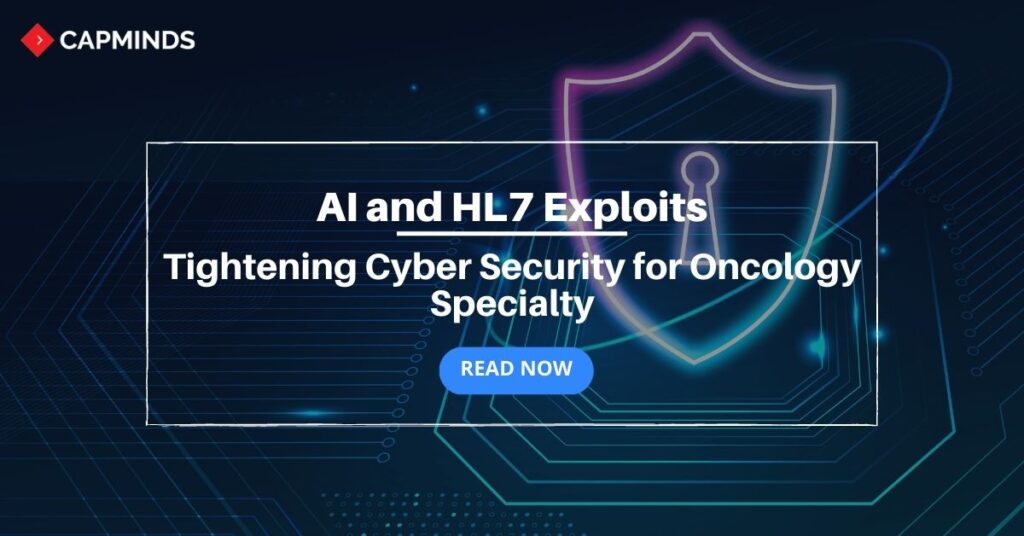AI and HL7 Exploits: Tightening Cyber Security for Oncology Specialty
In today’s digitized healthcare landscape, the use of artificial intelligence (AI) and Health Level Seven (HL7) protocols has revolutionized the field of oncology.
However, with these advancements come new challenges, particularly in ensuring the security and integrity of patient data. Cyberattacks targeting oncology specialties can have severe consequences, jeopardizing patient care, compromising confidential information, and hindering medical advancements.
RELATED: Top 15 HL7 Integration Challenges & Solutions for 2023
In this blog post, we will explore the vulnerabilities associated with AI and HL7 protocols, the potential exploits that cybercriminals can employ, and effective strategies to prevent and mitigate such attacks.
Understanding AI and HL7 in Oncology
Artificial intelligence plays a pivotal role in oncology, aiding in diagnostics, treatment planning, and personalized medicine.
RELATED: Case Study: Integrating HL7, FHIR, & API Capabilities with CapMinds
It leverages ML algorithms to analyze vast amounts of patient data and provide actionable insights. HL7, on the other hand, is a set of international standards that facilitates the exchange of electronic health records (EHRs) between healthcare systems.
Types of Vulnerabilities and Exploits
1. Data Breaches
2. Malware Attacks
3. Insider Threats
4. AI Model Poisoning
Preventing Cyber Attacks
To effectively prevent and mitigate cyber-attacks in oncology specialties, the following measures should be implemented:
1. Robust Network Security
- Implementing firewalls, intrusion detection systems, and regular network monitoring helps detect and prevent unauthorized access
- Encryption of sensitive data during transmission and storage is essential to maintain data integrity
2. Regular Updates and Patch Management
- Timely installation of software updates and patches is crucial to address known vulnerabilities
- AI systems, HL7 interfaces, and associated software must be kept up-to-date to mitigate potential exploits
3. Access Control and Authentication
- Implementing strict access controls and multi-factor authentication ensures that only authorized personnel can access sensitive patient data
- User roles and permissions should be clearly defined and regularly audited
4. Employee Training and Awareness
- Educating staff about cybersecurity best practices, like identifying phishing attempts, using strong passwords, and reporting suspicious activities, helps prevent successful attacks
- Regular training sessions and awareness campaigns can significantly reduce the risk of human error
5. Vendor Management
- When utilizing external vendors for AI systems or HL7 interfaces, it is crucial to perform due diligence in evaluating their security measures
- Contracts should include provisions for security audits and data protection to mitigate insider threats
6. AI Model Validation
- Rigorous validation and testing of AI models are essential to identify vulnerabilities and potential biases
- Regular audits of training data and model performance help ensure the accuracy and integrity of AI-driven diagnoses and treatment recommendations
How AI & HL7 Together Can Save the Oncology Specialty from Cyber-Attacks?
AI and HL7, when used together, can significantly enhance cybersecurity measures in the oncology specialty.
1. Threat Detection and Prevention
- AI-powered systems can analyze network traffic, user behaviors, and data patterns to identify potential cyber threats in real-time
- By continuously monitoring and analyzing vast amounts of data, AI can detect suspicious activities or anomalies that may indicate an ongoing cyber attack
- This early detection enables proactive measures to be taken to prevent or mitigate the impact of cyber attacks
2. Intelligent Intrusion Detection
- HL7 protocols facilitate the exchange of EHRs between healthcare systems
- By leveraging AI, these protocols can be enhanced with intelligent intrusion detection capabilities
- AI algorithms can analyze the exchanged data, detect any malicious attempts to modify or manipulate patient records and raise alerts for further investigation
3. Enhanced Data Security
- AI can be utilized to strengthen data encryption, access control, and authentication mechanisms
- By employing AI algorithms, healthcare organizations can implement robust encryption techniques to protect sensitive patient data during transmission and storage
- AI can also support advanced authentication methods like biometrics or behavioral analysis, to ensure that only authorized personnel can access patient records
4. Intelligent Threat Response
- When a cyber-attack occurs, AI can facilitate a rapid and intelligent response
- By utilizing ML algorithms, AI systems can quickly analyze and correlate various data points to identify the nature and extent of the attack
- This enables timely countermeasures and containment strategies to be implemented, minimizing the impact on patient care and data integrity
5. Predictive Analytics
- AI can leverage predictive analytics to identify potential vulnerabilities in the oncology specialty’s cybersecurity infrastructure
- By analyzing historical data and patterns, AI algorithms can proactively identify weak points or potential entry points for cyber attacks, enabling healthcare organizations to strengthen their defenses before an attack occurs
6. AI-Driven Threat Intelligence
- AI can assist in aggregating and analyzing threat intelligence data from various sources, including industry reports, security feeds, and vulnerability databases
- By employing AI algorithms, healthcare organizations can stay updated on the latest cyber threats and exploit specific to the oncology specialty
- This knowledge helps in developing and implementing targeted security measures to address emerging threats effectively
7. Continuous Monitoring and Auditing
- AI-powered systems can provide continuous monitoring of network activities, access logs, and user behaviors
- This enables the identification of any unusual or suspicious activities that may indicate a potential cyber attack
- Additionally, AI can automate audit processes to ensure compliance with security protocols and regulations, reducing the risk of human error and enhancing the overall cybersecurity posture
Final Thoughts
As AI and HL7 protocols continue to revolutionize oncology specialties, the importance of robust cybersecurity measures cannot be overstated.
Preventing and mitigating cyber attacks in oncology requires a comprehensive approach that addresses vulnerabilities, educates personnel, and implements stringent security measures. By safeguarding patient data, fortifying network security, and validating AI models, healthcare organizations can protect patient privacy, maintain trust, and continue to leverage the power of AI in advancing oncology care.
HL7 Integration Services from CapMinds
CapMinds Technologies offers the perfect all-in-one Health Interoperability solutions for your mental health clinical needs. Our HL7 FHIR services ease the innovatory exchange to create new possibilities. Our client-centered services keep them in the limelight. Our clinical & HL7 integrations enable EHR-integrated laboratory, imaging, e-prescriptions, EPCS, pharmacy, and much more. These enhance the activation process for your individual and collective needs.
“CapMinds Technologies is the place that will make you achieve your goals by combining “Expertise+Hardwork+Commitment”
CapMinds FHIR APIs services cover your patients’ health data with the greatest security, privacy, and confidentiality. We update ourselves with the latest versions like HL7 Version 2, Version 3, FHIR, SMART on FHIR, CDA, X12, HAPI FHIR, Mirthconnect, and security standards. CapMinds offers the best HL7 integration and HL7/FHIR interface development services for the federal government, health tech startups, laboratories, clinics, and practices.
“Unite with us to get the most benefits of our HL7 integration services and rise to be the first”



